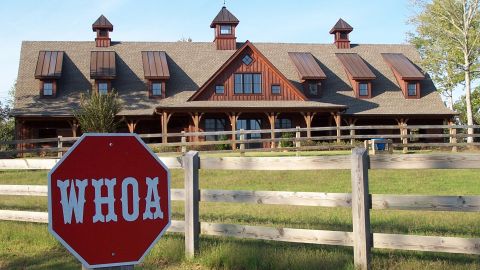According to a letter sent to ClubCo members earlier this month, parts
The Mountain Park course and clubhouse are set to open in the fall of 2011. Player moved his U.S. golf design operations to The Cliffs and purchased a large home there. The Tiger Woods course is a couple of years from completion and, let’s face it, does not have the same cachet it had before a certain fateful Thanksgiving night 13 months ago. (Anthony and Woods announced the High Carolina plans the summer before the star’s car crash and revelations of serial adultery.) High Carolina was “an unnecessary addition to the Cliffs formula,” according to our reader, and “…the debt raised may accelerate a split off of High Carolina, something I view as inevitable, and hopefully before it destroys value [in] the rest of the Cliffs.”
“Six courses to play is perfectly adequate,” he added, echoing what we have heard from other Cliffs members who play their home course most of the time, other nearby Cliffs courses occasionally, and the ones an hour away rarely. The three courses on Lake Keowee (Vineyard, Falls and Springs) are less than 20 minutes from each other, and those closer to Greenville, SC (Glassy, Valley, and Mountain Park when completed) are less than 30 minutes from each other. The “outlier” is The Cliffs at Walnut Cove, a challenging Jack Nicklaus course, which appears to be self-sustaining given the lure of nearby Asheville, NC.

Cliffs developer Jim Anthony and the group of residents who loaned him $60 million have suspended work on most of the communities' unfinished amenities, including the Tiger Woods golf course at High Carolina. Pictured is an established equestrian center at The Cliffs at Keowee.
During my first visit to The Cliffs in 2006, I marveled at the high-end amenities that included equestrian centers, wellness centers, expansive clubhouses, nature trails (with on-staff naturalists) and plans for even more. I wondered out loud to a friend how such spending could be sustained, even from the sales of home sites in the high-six figures. Of course, an ascendant housing market coupled with a huge and well-to-do baby boomer cohort caused many buyers not to think twice about subsidizing amenities they might never use. (Quick, think of all the golfing equestrians you know!) Then credit default swaps exerted their gravitational pull on the housing market and all those baby boomers’ plans. The Cliffs is not alone among high-end golf communities with cash flow issues.
Developers who pushed an all-amenities-to-all-people business model have had a sobering few years. Although he certainly could be accused of overreaching, The Cliffs’ Jim Anthony is no Bobby Ginn; Cliffs properties may have lost some significant value in the last three years, but their owners still speak of Anthony in reverential terms (the opposite of how Ginn owners feel about their bankrupt developer). They want Anthony’s vision to triumph as much as they want their investments to hold. In an ironic way, the economy may have done Anthony and The Cliffs a favor. The members who loaned Anthony the $60 million will act as a governor on his loftier -– and expensive –- dreams.
This new financial partnership among owners and developer, as well as spending to match cash flow, could very well become a model for other upscale golf communities that got way ahead of themselves.

The golf at all six Cliffs courses is undeniably excellent, which makes some members wonder if the Tiger Woods course, which will follow a new Gary Player course, is necessary.



